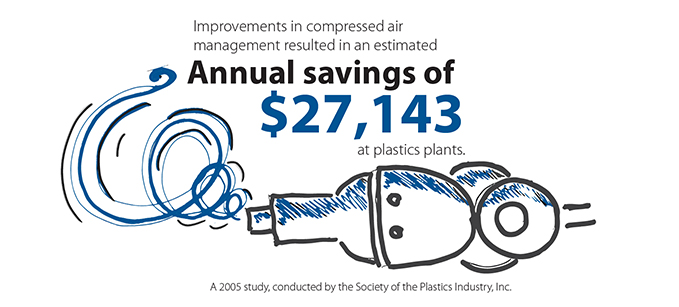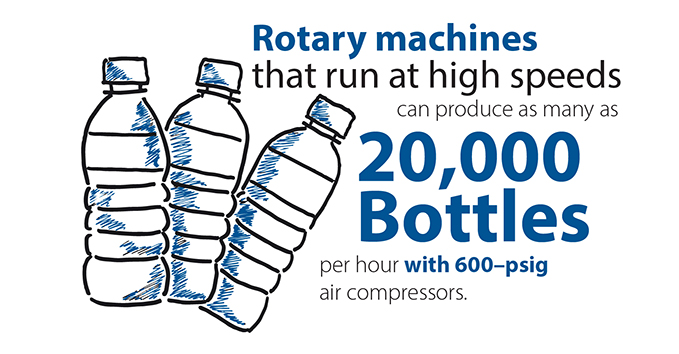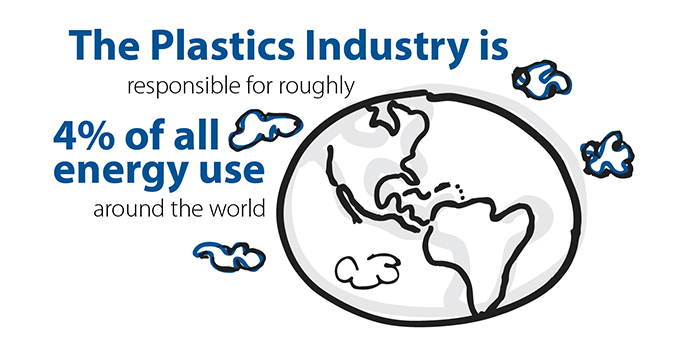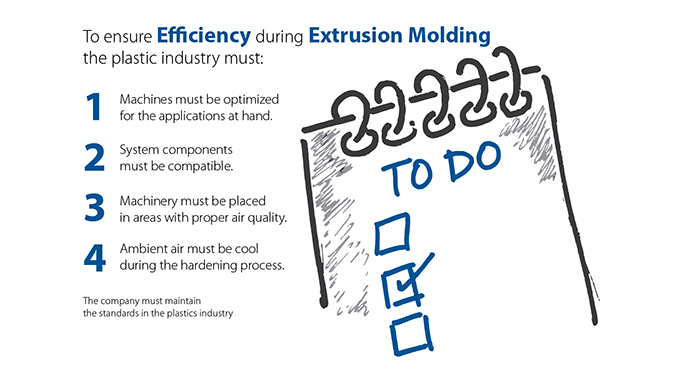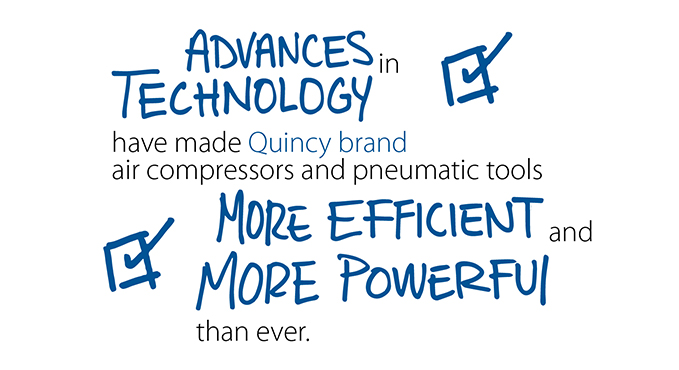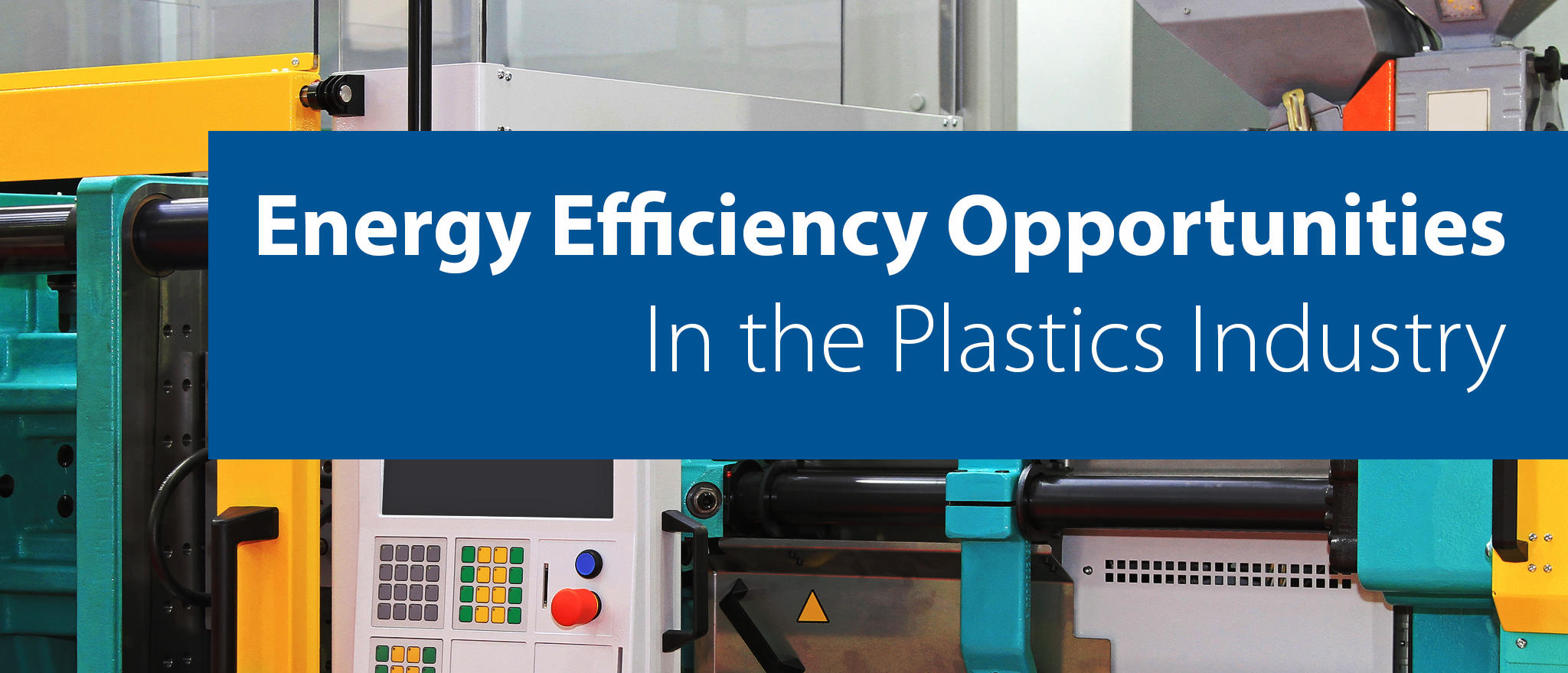
Plastic is one of the most essential products in today’s world. As such, it is among the more commonly produced materials. Like most modern day products, its production relies heavily on compressed air, which is vital across all corners of the plastics industry. In everything from blow molding to injection molding, air compressors help operators manufacture plastics with utmost efficiency.
When it comes to plastic molding, compressed air makes it possible to achieve numerous tasks in seconds that would otherwise take minutes or even hours by hand, including:
- The extrusion of plastics in a tube–like heated form during the pre–molding stage.
- The cooling of newly molded plastics into a hardened, permanent form.
- The post–treatment of formed plastic objects prior to commercial use.
Before a mass–produced set of plastics — be it bottles or containers — are filled with products for over–the–counter consumption, compressed air is often used to blow the insides clean for sanitation purposes.
Contact Us Learn More Find a Dealer Near You
The Monetary Benefits of Plastics Industry Compressed Air Efficiency
A 2005 study, conducted by the Society of the Plastics Industry, Inc. in coordination with the U.S. Department of Energy, found that improvements in compressed air management resulted in an estimated annual savings of $27,143 at plastics plants. The figure was based on the combined benefits of 29 recommended improvements — such as stopping leaks and buying smaller or more efficient compressors — in the maintenance of air compressors.
Essentially, the plastics industry can reduce overhead and boost profit margins by implementing many of the same efficiency measures use in other industries when it comes to air compressors. The benefits of these measures include:
- Power savings, thanks to stopped leaks, ensures that compressed air is better conserved at point of use.
- Energy savings by not using as much electricity to create compressed air that is lost through leaks.
- Sufficient pressure for each application.
- Proper air temperatures to ensure that machines run effectively and applications work as intended.
- Regular drainage, which keeps an air compressor free of condensation buildup.
- Clean filtration, which prevents dust, oil and water particulates from tainting compressed air.
The savings that plastics companies can gain by taking these steps results in numerous benefits across all corners of the process. Not only do operations become more profitable, but also products ultimately improve in quality, which leads to a better profile in the marketplace.
Productivity in the Plastics Industry With Compressed Air Efficiency
In the majority of plants that employ blow molding methods, air compressors are used to expand the parison, which is the tube–shaped initial form of heated plastics used in the process. Thanks to the power of compressed air technology, blow methods can be very lucrative for the plastics industry in terms of production. In PET bottle blowing, for example, rotary machines that run at high speeds can produce as many as 20,000 bottles per hour with 600–psig air compressors.
When you think about the productivity level that figure represents, and what it means when multiplied across 8—10-hour working days, across 5—6-day workweeks, across roughly 40 weeks of operation annually, the numbers are staggering. Theoretically, a large plastics plant could turn out products at the following rate when powered by an efficient system:
- 200,000 bottles a day on a 10–hour shift.
- One million bottles per week in the span of five days.
- Four million bottles over the course of a month.
- 48 million bottles in the span of a year.
Modern day productions are capable of yielding the most staggering numbers, and much of this is due to the remarkable power of compressed air technology.
Problems That Can Hinder Compressed Air Efficiency in the Plastics Industry
However, high productivity could negatively affect compressed air efficiency opportunities in the plastics industry, unless companies take steps to reduce pressure drop inside the molding machines. Pressure drop stems from the amount of air power that a system ends up consuming during high–level productions. For example, a blow system might use as much as 3,200 scfm in the time it takes to produce 24,000 bottles.
Pressure drop is bad for numerous reasons, because it undermines the purpose of compressed air technology. For instance, when drastic pressure drop occurs between the compressor and point of use, applications suffer in the following ways:
- Insufficient pressure passes through the hose that connects the pressure to the tool tip.
- Tools don’t receive enough air to drive heavy–duty applications.
- The end results of applications are rendered unsatisfactory.
- Plastics plants lose money when finished good of inferior quality have to be discarded and redone.
Consequently, pressure drop can put plants behind schedule and severely cut into profit margins, because materials have to then be repurchased for do–over productions.
For obvious reasons, plastics industry compressed air efficiency is most effective when molding machine pressure drop is drastically minimized. Typically, this necessitates either the removal or higher–capacity upgrade of certain pneumatic attachments. Determining the actual level of pressure drop over the course of operations can be difficult, even with the use of transducers and electronic reading devices. Therefore, it’s most advisable to hire a compressed air specialist when performing efficiency upgrades to a plastics molding system.
Methods of Compressed Air Molding Used in the Plastics Industry
The plastics industry is responsible for roughly 4% of all energy use around the world. In 2012 alone, global plastic production accounted for 288 million tons of product. Two–thirds of this productivity occurred in China, Europe and North America. The industry’s energy consumption is generally split into the following four categories:
- Material Melting — With plastics, this involves the melting of hard pieces into thick or fluid liquid form for the purpose of molding.
- Equipment Operation — Along the assemblies at plastics pressings plants, many of the tools and machines are powered by air compressors.
- Product Cooling — After a plastic object has been formed, it needs to be cooled into a solid, permanent state. Manufacturers generally use compressed air for this process.
- Manufacturing — Once a line of plastic products has been produced, each item must be prepared for shipment. Various pneumatic tools feature in this process.
While manufacturers use numerous processes for production in each of the four categories, the most frequently utilized are the extrusion and injection/blow molding methods.
The Extrusion Method of Plastic Molding
Extrusion is an ongoing method in the manufacturing of equipment like tubes, cable covers, films and profiles. While differences exist between production assemblies in the actual mold designs and extrusion parts put to use, the general methods are pretty much the same.
The extruder is first filled with plastic pellets, which are then heated in a screw–driven barrel. The heat ultimately melts the pellets into liquid plastic. The heating process itself is aided by oils that are temperature–set, usually by electronic means. The melted plastic is then molded into shape and cooled to a hardened state, using either liquid or compressed air. Further modifications, such as trimming, are then made as needed.
The extrusion method can be broken down as follows:
- An extruder melts plastic into a fluid state.
- The melted plastic is molded into shape.
- Once molded, the plastic is cooled into a solid state.
- The newly formed plastic object is sent onward for additional modifications.
The whole process is direct and simple, yet none of it would be possible without the types of high–tech pressing arsenals employed at today’s facilities, where compressed air plays a vital role.
Energy Savings With Extrusion Molding
Throughout the whole process of extrusion, heaters, coolers and compressors consume the most energy. Pressing plants think of the consumption of energy in much the same way as the ‘time is money’ principle. This way, it’s easiest to harness compressed air efficiency opportunities in the plastics industry, because consumption is correlated to productivity. The concept goes as follows:
- The company earmarks set amounts of money for productions within select time spans.
- Productions must be efficient in order to keep things on schedule.
- Only when things stay on schedule can productions remain within budget.
- If productions can be expedited, profit margins can be boosted.
- Profitable accelerations of productivity can only be achieved with utmost system efficiency.
In order to conserve energy throughout the process of extrusion, it’s crucial to select the proper extruder. If disparities are present in the screw and mold components, energy goes to waste during the process. The extruder must also be able to run at sufficient speeds and placed in an area with proper insulation. Companies should melt pellets at low temperatures and cool them with air compressors of maximum efficiency. Moreover, the cooling process works best in settings where the ambient air is relatively cool.
Essentially, the company must maintain the following standards in the plastics industry to ensure efficiency during extrusion molding:
- Machines must be optimized for the applications at hand.
- System components must be compatible.
- Machinery must be placed in areas with proper air quality.
- Ambient air must be cool during the hardening process.
With air compressors, consistent and proper time maintenance ensure reliable operations. Avoiding maintenance can lead to insufficient air pressure that can hamper the process of plastics molding.
Injection Molding in the Plastics Industry
Injection molding is a method for making plastic parts, and it’s carried out in cycles. The method consists of plastic fluid injections into a shape maker, which can all be accomplished and repeated in quick succession. Due to this efficiency, the method is often favored in the manufacturing sector.
The entire process works as follows: hard plastic is melted into fluid, which is then injected through a nozzle that leads to a pre–shaped molding compartment that forms each new injection into a uniform shape. The shape–maker consists of mirrored halves joined together for the molding stage, and then parted to release the newly formed plastic object. Once free, the object moves along the assembly for further modifications, such as cutting and labeling.
Essentially, the process of injection molding can be broken into the following steps:
- Plastic is melted into fluid form.
- Fluid plastic is squeezed through nozzle.
- Shape–makers join around the plastic from both sides.
- Plastic molds into the form.
- Newly formed plastic object moves onward for further refinement.
Objects such as plastic cups are given perfect symmetry by the mirrored halves that join during the molding stage of the injection method.
The types of plastic products regularly produced through the method of injection molding run the gamut in terms of uses. Examples of everyday parts and accessories brought into existence through this method include the following:
- Baskets — From the kitchen baskets sold at home–supply stores to the grocery baskets available to shoppers at supermarkets, injection molding is generally the process responsible.
- Device Enclosures — Handheld and desktop devices often feature plastic encasing that is produced through the method of injection molding. Examples of such devices include everything from calculators to gaming consoles.
- Bathroom Accessories — It’s not just hairspray bottles and gel containers that generally come from plastics pressing plants, as such facilities also produce the shells that encase the circuitry of blow dryers, disposable razors and hair curlers.
A great number of tools and accessories we depend on daily for purposes like grooming, cooking, doing paperwork and engaging in leisurely fun are products of plastics plants.
Energy Efficiency With Injection Molding
The usage of energy during the process of injection molding can easily be split into two parts. During the first part, high amounts of energy are used — from the time that the fluid is injected and until the shape–maker opens to reveal the newly formed plastic object. As the object cools into its permanent solidity, less energy is consumed. The reasons for this energy consumption are as follows:
- The squeezing of plastic through nozzles necessitates high amounts of air pressure.
- The closing and opening of mold–making parts requires optimal system energy.
The lion’s share of energy is divided between the system motors and heating components, while smaller amounts are used by accessories in the whole process. Therefore, plastics industry efficiency is often easiest to harness through the fine-tuning of processes during the crucial shape–making stage of injection molding.
In order for the process of injection molding to be as efficient as possible, mechanics should constantly check the parts in use during the shape–making stage for optimal performance capabilities — this would entail the periodic cleaning of molding components. Additionally, make sure that the pressure settings are most suitable for the production in question. The maintenance steps that help ensure efficiency during injection molding are as follows:
- Clean the nozzles regularly to ensure the easy flow of plastic.
- Inspect the mold–making components for lingering plastic traces.
- Clean the mold components periodically to ensure ideal shape–making.
- Ensure that ambient temperatures are ideal for hot, fluid plastics, as well as for plastic cooling.
- Make sure that ambient air remains free of moisture and oil through preventative steps against condensation in the system machinery.
As far as compressed air efficiency is concerned, units equipped with variable speed drives are generally most optimal for the process of injection molding. The process is most efficient when you give equal consideration to the cleanliness of machine parts and the speed at which each object can be completed.
Blow Molding in Mass Plastic Production
Blow molding is the process that forms many of the plastic objects that are seen on the shelves at supermarkets, such as food containers and liquid bottles. The process centers around air compressors, which are used to blow preheated plastics into shape. As with other methods of shape making, it all begins with the extraction of hot plastic in fluid form. In fact, blow molding can be divided into two categories: extrusion blow molding and injection blow molding.
- With the extrusion method of blow molding, liquid plastic is squeezed into a tube–like extract, then enclosed with shaping contraptions. Once the plastic has formed into a firm object, compressed air blows it dry into a permanently hardened state.
- Injection blow molding starts out with the formation of a pre–mold, which is reheated and dried with compressed air. In some cases, the final blowing occurs at a different facility from where the initial molding takes place.
In order for the plastics industry to achieve compressed air efficiency through blow molding, they should enact the same principles that apply to other methods. Professionals must periodically clean the equipment used in the shape–making stages to ensure that proper formation occurs. Additionally, air compressors used in plastic making should be lubricated and drained regularly to prevent condensation and the aerosolization of harmful oils in the process.
Quincy Compressors Boost Plastics Industry Efficiency
Nearly a hundred years have passed since two of the greatest developments of the Industrial Revolution: the plastics boom and the development of air compressors. From the moment these developments first began, Quincy Compressor has been among the world’s leading innovators in compressed air technology. In the United States, Canada and overseas, our machines have been used in the manufacturing of plastics for everything from food and drink containers to medicine bottles. With our vast range of compressors, tools and accessories, plastics plants turn to us for equipment and service.
Over the past few decades, advances in technology have made the Quincy brand of air compressors more powerful and efficient than ever. For all these reasons and more, our products have been a vital tool for plastics industry compressed air efficiency. When it comes to boosted productivity with minimal power consumption, Quincy air compressors make it possible for a variety of sized operations to realize inefficiencies. Likewise, our compressors make it easier for plants to expand their supply for greater productivity, and at the same time enjoy healthier profit margins.
As nations move to cut down on emissions and develop more eco–friendly means of production, there are more compressed air efficiency opportunities in the plastics industry than ever before. From quicker blow molding to easier injection molding, plastic pressing plants are boosting productivity and conserving power in the process. Best of all, air compressors allow factories to reduce on–the–floor personnel and render hard tasks easy.
At Quincy, we understand that production machinery is easiest to maintain and maximize to its fullest when controls are easy to operate and the components are accessible for routine maintenance. Those are just some of the reasons why Quincy air compressors are preferred at factories around the world. To learn more about the many things that Quincy air compressors can do for your factory operations, click on over right now to our sales and service locator page.
Table of Contents
- Monetary Benefits of Plastics Industry
- Productivity in the Plastics Industry
- Problems That Can Hinder Compressed Air Efficiency
- Methods of Compressed Air Molding
- Extrusion Method of Plastic Molding
- Energy Savings With Extrusion Molding
- Injection Molding in the Plastics Industry
- Energy Efficiency With Injection Molding
- Blow Molding in Mass Plastic Production
- Boost Plastics Industry Efficiency


